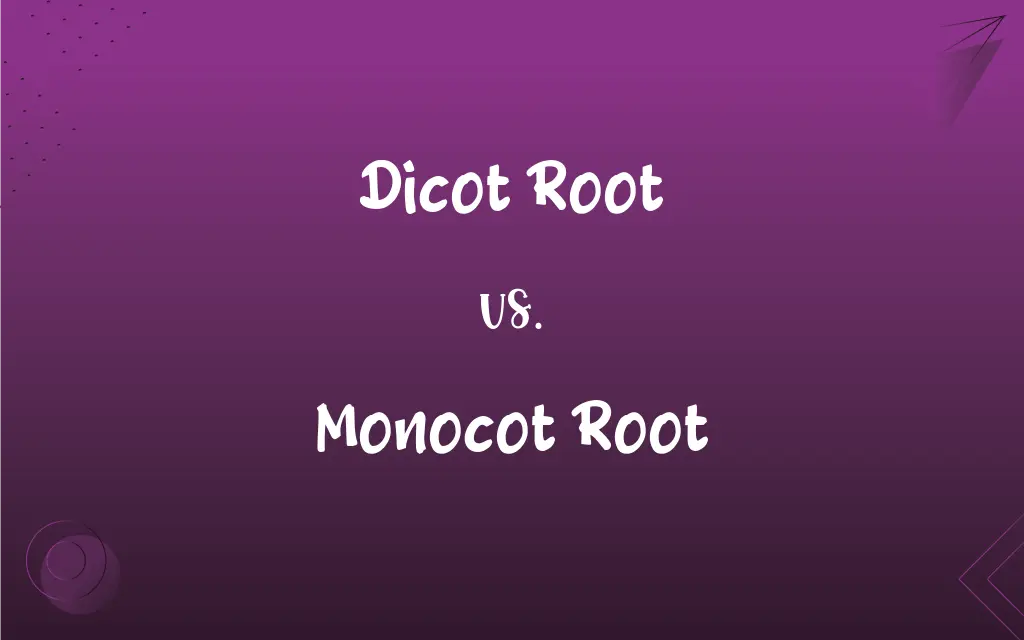Dicot Root vs. Monocot Root: What's the Difference?
Edited by Janet White || By Harlon Moss || Updated on October 3, 2023
Dicot roots typically have a xylem in star shape and cambium present, while monocot roots have a xylem and phloem in a ring shape and no cambium.

Key Differences
Dicot roots and monocot roots differentiate primarily through their vascular bundle arrangements and number of seed leaves or cotyledons. The dicot root generally demonstrates a specific anatomical pattern that distinguishes it from its monocot counterpart. In the case of dicot roots, the xylem and phloem are arranged in a star-like pattern, a feature that enables a distinct functionality in terms of nutrient and water transport.
On the other side, monocot roots display a vascular bundle pattern where the xylem and phloem are organized in a circular manner. Monocot roots exhibit certain characteristic features which include a pith, and lack of secondary growth. This structural formation aids in a specialized nutrient transport mechanism which varies significantly from the dicot roots.
Secondary growth, which is often associated with an increase in thickness, is commonly found in dicot roots due to the presence of a vascular cambium. This element of secondary growth is crucial for the support and longevity of dicot plants, ensuring that they can acquire and transport nutrients efficiently as they mature and grow.
Monocot roots, however, typically do not undergo secondary growth because they lack vascular cambium. Consequently, the absence of secondary growth in monocot roots implies that they don't thicken over time. This inherently affects the longevity and structural development of monocot plants, directing them towards a different evolutionary pathway in comparison to dicot plants.
It's also noteworthy that dicot roots usually initiate from the radicle (embryonic root), providing them a structural starting point that influences subsequent development. Whereas, monocot roots often tend to exhibit more adventitious roots, meaning they can sprout from stems and leaves, displaying a diverse array of origination points which in turn influences their overall growth pattern and structural support system.
ADVERTISEMENT
Comparison Chart
Vascular Arrangement
Xylem is in a star shape
Xylem arranged in a circle
Secondary Growth
Present due to cambium
Absent, no cambium
Origin of Roots
Mainly from radicle
Often adventitious
Number of Cotyledons
Two
One
Root Development
Can develop thicker roots
Generally remain thin
ADVERTISEMENT
Dicot Root and Monocot Root Definitions
Dicot Root
A dicot root possesses two cotyledons in its seed and typically has a star-shaped vascular arrangement.
The oak tree has a dicot root that exhibits a distinct star-shaped xylem.
Monocot Root
Monocot roots can be adventitious, meaning they might emerge from parts of the plant other than the radicle.
In corn, a monocot, roots can emerge from the stem, providing additional support.
Dicot Root
The vascular cambium in dicot roots facilitates the production of additional xylem and phloem.
The dicot root of a rose plant facilitates the plant's growth by producing new vascular tissue.
Monocot Root
Monocot roots feature a single cotyledon and have a vascular bundle arranged in a circular pattern.
The rice plant exhibits a classic monocot root structure with a ring-like vascular arrangement.
Dicot Root
Dicot roots usually exhibit secondary growth, enabling the thickening of the root as the plant ages.
Over time, the carrot, having a dicot root, becomes thicker through secondary growth.
Monocot Root
Generally, monocot roots lack a vascular cambium, preventing secondary growth and thickening of the roots.
The roots of grass, a monocot, remain thin and do not experience secondary growth.
Dicot Root
Dicot roots frequently originate from the radicle, developing into a primary root system.
In beans, the dicot root develops directly from the radicle, providing support and nutrient transport.
Monocot Root
Monocot roots typically do not undergo secondary growth and thus do not become woody or thick.
The garlic plant, having a monocot root, does not develop a thick, woody root structure.
Dicot Root
Dicot roots are typically found in plants like shrubs and trees, contributing to robust structural support.
The dicot root of a sunflower supports its upright growth and facilitates nutrient uptake from the soil.
Monocot Root
Monocot roots are prevalent in herbaceous plants and grasses, supporting slender and flexible structures.
Wheat, with its monocot root, sustains a flexible stem and is generally non-woody in nature.
FAQs
Why don’t monocot roots undergo secondary growth?
Monocot roots do not undergo secondary growth primarily because they lack vascular cambium, preventing the formation of additional vascular tissues and thickening of roots.
Can monocot roots emerge from stems or leaves?
Yes, monocot roots can be adventitious, emerging from various plant parts like stems, providing additional structural support.
Can dicot roots develop into woody structures?
Yes, dicot roots can develop into woody structures due to the capability for secondary growth and thickening over time.
Are monocot roots typically found in herbaceous plants?
Yes, monocot roots are commonly found in herbaceous plants and grasses, which usually do not develop woody or thick roots.
Do dicot roots always develop from the radicle?
Dicot roots predominantly develop from the radicle, although some dicot plants might also have adventitious roots.
How do vascular arrangements affect nutrient transport in dicot roots?
The star-shaped vascular arrangement in dicot roots efficiently separates xylem and phloem, facilitating effective nutrient and water transport.
What defines a dicot root?
A dicot root is typically defined by its two cotyledons, star-shaped vascular arrangement, and the potential for secondary growth.
How does secondary growth occur in dicot roots?
In dicot roots, secondary growth occurs due to the presence of vascular cambium, which facilitates the production of additional xylem and phloem, leading to thickening roots.
Is the vascular bundle arrangement in monocot roots efficient for nutrient transport?
Yes, the ring-like vascular bundle arrangement in monocot roots aids in effective nutrient and water transport despite lacking secondary growth capability.
What is a pith, and is it found in monocot roots?
The pith is a central, spongy, and often larger area in roots or stems. It is commonly found in monocot roots, situated inside the ring-like vascular arrangement.
Is it possible to identify a plant type based on its root structure alone?
While root structures like dicot and monocot roots can provide hints, caution is advised as exceptions and variations exist. Additional characteristics should also be considered for accurate identification.
Can monocot plants exhibit robust structures despite having thin roots?
Yes, monocot plants, like some palm trees, can exhibit robust and tall structures despite having roots that don’t undergo secondary growth.
Can plants be genetically modified to alter their root type from monocot to dicot, or vice versa?
While genetic modifications in plants are possible, altering a plant from monocot to dicot or vice versa would require complex genetic alterations and is not currently practiced in genetic engineering.
Are dicot roots generally associated with larger plants like trees and shrubs?
Yes, dicot roots are commonly found in larger plants like trees and shrubs, providing robust support and efficient nutrient transport.
How does the absence of secondary growth in monocot roots influence plant size and lifespan?
The absence of secondary growth in monocot roots usually limits the thickness and robustness of the plant, often resulting in plants that are shorter and have a shorter lifespan compared to many dicots.
How does the presence of cambium in dicot roots affect plant health and longevity?
The presence of cambium enables dicot roots to produce new vascular tissues, supporting sustained nutrient transport, health, and potentially longer longevity of the plant.
Do dicot roots typically have a wider variety of plant species?
Yes, dicot roots are associated with a wide variety of plant species, including both herbaceous plants and woody plants like trees.
How do monocot roots adapt to support plants without secondary growth?
Monocot roots may develop extensive, fibrous root systems or adventitious roots that provide additional stability and nutrient absorption capabilities without secondary growth.
What is a notable feature of monocot roots?
Monocot roots generally have a circular vascular bundle arrangement and lack the capability for secondary growth due to the absence of vascular cambium.
What is a common example of a plant with a monocot root?
Grass is a common example of a plant with a monocot root, demonstrating characteristic features like a ring-like vascular arrangement and lack of secondary growth.
About Author
Written by
Harlon MossHarlon is a seasoned quality moderator and accomplished content writer for Difference Wiki. An alumnus of the prestigious University of California, he earned his degree in Computer Science. Leveraging his academic background, Harlon brings a meticulous and informed perspective to his work, ensuring content accuracy and excellence.
Edited by
Janet WhiteJanet White has been an esteemed writer and blogger for Difference Wiki. Holding a Master's degree in Science and Medical Journalism from the prestigious Boston University, she has consistently demonstrated her expertise and passion for her field. When she's not immersed in her work, Janet relishes her time exercising, delving into a good book, and cherishing moments with friends and family.































































